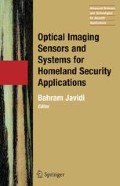Access this chapter
Tax calculation will be finalised at checkout
Purchases are for personal use only
Preview
Unable to display preview. Download preview PDF.
References
An X, Psaltis D, and Burr GW. (1999). “Thermal fixing of 10,000 holograms in LiNbO3: Fe.” Appl. Opt., 38:386–393.
Bruning JH, Herriott DR, Gallagher JE, Rosenfeld DP, White AD, and Brangaccio DJ. (1974). “Digital wavefront measuring interferometer for testing optical surfaces and lenses.” Appl. Opt., 13:2693–2703.
Casasent D. (1984). “Unified synthetic discriminant function computational formulation.” Appl. Opt., 23:1620–1627.
Caulfield HJ. (1979). Handbook of Optical Holography. Academic, London.
Esteve-Taboada JJ, Mas D, and García J. (1999). “Three-dimensional object recognition by Fourier transform profilometry.” Appl. Opt., 38:4760–4765.
Frauel Y and Javidi B. (2001). “Neural network for three-dimensional object recognition based on digital holography.” Opt. Lett., 26:1478–1480.
Frauel Y, Pauliat G, Villing A, and Roosen G. (2001). “High-capacity photorefractive neural network implementing a Kohonen topological map.” Appl. Opt., 40:5162–5169.
Frauel Y, Tajahuerce E, Castro M-A, and Javidi B. (2001). “Distortion-tolerant 3D object recognition using digital holography.” Appl. Opt., 40:3887–3893.
Frauel Y, Tajahuerce E, Matoba O, Castro A, and Javidi B. (2004). “Comparison of passive ranging integral imaging and active imaging digital holography for three-dimensional object recognition.” Appl. Opt., 43:452–462.
Goodman JW. (1968). Introduction to Fourier Optics. McGraw-Hill, New York.
Goodman JW and Lawrence RW. (1967). “Digital image formation from electronically detected holograms.” Appl. Phys. Lett., 11:77–79.
Guerrero-Bermudez J, Meneses J, and Gualdrón O. (2000). “Object recognition using three-dimensional correlation of range images.” Opt. Eng., 39:2828–2831.
Horner JL and Gianino PD. (1984). “Phase-only matched filtering.” Appl. Opt., 23:812–816.
Javidi B. (1989). “Nonlinear joint power spectrum based optical correlation.” Appl. Opt., 28:2358–2367.
Javidi B, ed. (2002). Image Recognition and Classification: Algorithms, Systems, and Applications. Marcel-Dekker, New York.
Javidi B and Horner JL. (1994). Real-time Optical Information Processing. Academic, Orlando.
Javidi B and Okano F, eds. (2002). Three-Dimensional Television, Video, and Display Technologies. Springer-Verlag, Berlin.
Javidi B and Painchaud D. (1996). “Distortion-invariant pattern recognition with Fourier-plane nonlinear filters.” Appl. Opt., 35:318–331.
Javidi B and Tajahuerce E. (2000). “Three-dimensional object recognition using digital holography.” Opt. Lett., 25:610–612.
Lippmann G. (1908). “La photographie intégrale.” Comptes-rendus de l’Académie des Sciences, 146:446–451.
MacAulay AD. (1991). Optical Computers Architectures. John Wiley, New York.
Mas D, Garcia J, Ferreira C, Bernardo LM, and Marinho F. (1999). “Fast algorithms for free-space diffraction patterns calculation.” Opt. Commun., 164:233–245.
Matoba O, Tajahuerce E, and Javidi B. (2001). “Real-time three-dimensional object recognition with multiple perspectives imaging.” Appl. Opt., 20:3318–3325.
Okoshi T. (1971). Three-dimensional Imaging Techniques. Academic, New York.
Pu A, Denkewalter R, and Psaltis D. (1997). “Real-time vehicle navigation using a holographic memory.” Opt. Eng., 36:2737–2746.
Refrégiér Ph, Laude V, and Javidi B. (1994). “Nonlinear joint transform correlation: An optimum solution for adaptive image discrimination and input noise robustness.” Opt. Lett., 19:405–407.
Ritter H, Martinetz T, and Schulten K. (1992). Neural Computation and Selforganizing Maps. Addison-Wesley, New York.
Rosen J. (1998). “Three-dimensional joint transform correlator.” Appl. Opt., 37:7538–7544.
Schnars U and Jüpter W. (1994). “Direct recording of holograms by a CCD target and numerical reconstruction.” Appl. Opt., 33:179–181.
Tajahuerce E, Matoba O, and Javidi B. (2001). “Shift-invariant three-dimensional object recognition by means of digital holography.” Appl. Opt., 40:3877–3886.
VanderLugt AB. (1964). “Signal detection by complex spatial filtering.” IEEE Trans. Inf. Theory IT, 10:139–145.
VanderLugt AB. (1992). Optical Signal Processing. John Wiley, New York.
Weaver CS and Goodman JW. (1966). “A technique for optically convolving two functions.” Appl. Opt., 5:1248–1249.
Yamaguchi I and Zhang T. (1997). “Phase-shifting digital holography.” Opt. Lett., 22:1268–1270.
Author information
Authors and Affiliations
Editor information
Editors and Affiliations
Rights and permissions
Copyright information
© 2006 Springer Science+Business Media, Inc.
About this chapter
Cite this chapter
Frauel, Y., Tajahuerce, E., Matoba, O., Castro, A., Javidi, B. (2006). 3D Object Reconstruction and Recognition Techniques Based on Digital Holography. In: Javidi, B. (eds) Optical Imaging Sensors and Systems for Homeland Security Applications. Advanced Sciences and Technologies for Security Applications, vol 2. Springer, New York, NY. https://doi.org/10.1007/0-387-28001-4_1
Download citation
DOI: https://doi.org/10.1007/0-387-28001-4_1
Publisher Name: Springer, New York, NY
Print ISBN: 978-0-387-26170-6
Online ISBN: 978-0-387-28001-1
eBook Packages: Physics and AstronomyPhysics and Astronomy (R0)

